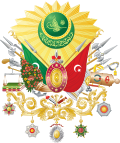Top Qs
Timeline
Chat
Perspective
Sanjak of Viçitrina
Sanjak of the Ottoman Empire from 1459 to 1864 From Wikipedia, the free encyclopedia
Remove ads
The Sanjak of Viçitrina (Albanian: Sanxhaku i Vushtrrisë; Serbian: Вучитрнски санџак / Vučitrnski sandžak; Turkish: Vulçitrin sancağı), also known as the Pristina Pashaluk (Albanian: Pashallëku i Prishtinës; Serbian: Приштински пашалук / Prištinski pašaluk), was a sanjak (second-level administrative division) of the Ottoman Empire in Rumelia (the Balkans), in present-day Kosovo. It was named after its administrative center Vushtrri.
Remove ads
History
Summarize
Perspective
Vushtrri was captured from the Serbian Despotate by the Ottomans in 1455, it remained under control of the governor of Sanjak of Üsküp until the definite annexation of the Serbian Despotate in 1459.[1] The first Ottoman records include the territory of the sanjak as Vilayet-i Vlk (Vilayet of Vuk), a reference to Vuk Branković.
According to Ottoman defters of 1525—1561 the sanjak of Vushtrri included the following towns: Vushtrri , Pristina, Janjevo, Novo Brdo, Belasica, Belo Brdo, Koporići, Trepča and Donja Trepča.[2] In 1459-1826 it was part of Rumelia Eyalet, except for a brief period after 1541 when it was included into newly established Budin Eyalet.[3] It was also part of Temeşvar Eyalet briefly before returning to Rumelia Eyalet.
Contemporary documents like the 1566-7 defter of the sanjak show that the c. 1000 villages of the region were mostly inhabited by Christians, with Muslims comprising forty-six households not in compact communities but spread in thirty villages.[4] As in nearby Pristina the rate of conversion of Orthodox Slavs to Islam was low. Ottoman traveller Evliya Çelebi visited the capital of the sanjak in 1660 and observed that the population spoke "Albanian and Turkish, but not Bosnian".[5] According to Ottoman sources, sanjak was inhabited with Albanians, Vlachs, Slavs, Turks, Gypsies and others, of Muslim, Orthodox and Catholic confessions.[6] Among the Christians a Catholic community also existed as evidenced by a local landmark known as the "Latin cemetery" (Albanian: varrezat latine).[7]
In 1717, during the Austro-Turkish War, an uprising broke out in the sanjak, raised by the Serb rayah. It was brutally suppressed.[8]
In 1864 during the administrative reforms of the era, it was demoted to a kaza of the newly established sanjak of Pristina.[9]
Remove ads
Economy
A group of mines on the Kopaonik mountain together with those in Novo Brdo and Janjevo belonged to this sanjak.[10]
Governors
- Hussein Bey
- Malik Pasha (fl. 1807–1820s)
- Yashar Pasha (fl. 1830–1836)
References
Wikiwand - on
Seamless Wikipedia browsing. On steroids.
Remove ads
